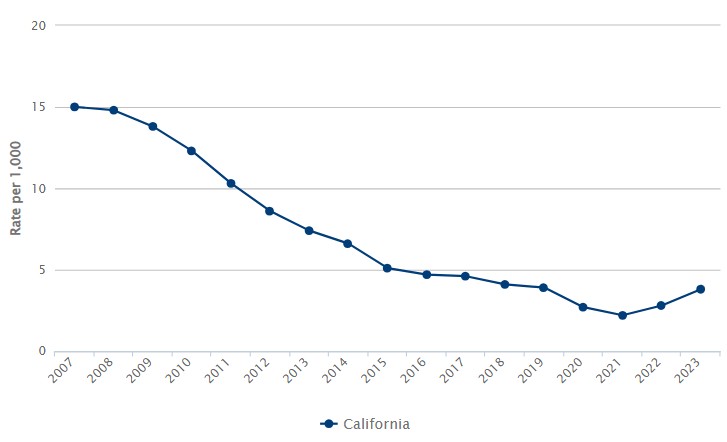Juvenile Felony Arrests in California Rise by 76% in Two Years
A statement about data access and integrity:
KidsData remains committed to providing high-quality data and fact-based information to anyone who cares about advancing health and well-being in our state and across our nation.
Without evidence, we risk obscuring or distorting the realities that California’s children and families experience. KidsData exists to describe those realities in detail, so that they can guide sound decision-making.
Read a statement from PRB’s president, Jennifer Sciubba, here.
Youth who become involved with the justice system are at increased risk for negative outcomes that can have long-term consequences, such as mental health problems, dropping out of school, difficulty with employment, and rearrest. Most young people who are detained have experienced some form of trauma during childhood, and system involvement can retraumatize them, often with no benefits for crime control or public safety.
Number of Juvenile Felony Arrests per 1,000 California Young People Ages 10 to 17:
2007 to 2023
For the first time since 2007, California recorded two consecutive years of rising juvenile felony arrest rates in 2022 and 2023. Young people ages 10 to 17 were arrested for felony offenses at a rate of 3.8 arrests per 1,000 juveniles in 2023—up from a forty-plus-year low of 2.2 per 1,000 in 2021, and similar to rates before the COVID-19 pandemic (3.9 per 1,000 in 2019). This two-year upswing is the largest since the late 1980s.
There were 6,913 more juvenile felony arrests statewide in 2023 than in 2021—an increase of 76%. The number of arrests involving girls jumped by 87% over this period, while arrests of boys climbed 73%.
Violent and property offenses together accounted for nearly 70% of the state’s juvenile felony arrests in 2023, drug/alcohol and sex offenses accounted for less than 5%, and driving under the influence, hit-and-runs, weapons charges, and other crimes made up the remaining share. These percentages resemble the distributions for 2020 and 2019.
Policymakers and leaders from multiple sectors can play a role in improving how society responds to youth behavioral problems and juvenile crime. Explore policy and practice options on KidsData.
Children’s Health Resources
2025 California County Scorecard of Children’s Well-Being
Children Now has released the 2025 edition of its interactive data scorecard tracking 40 indicators of child well-being. Explore the latest county-level figures, compare data across racial/ethnic groups, and examine trends over time.
A 2024 Review of Child Care and Early Learning in the United States
The Center for American Progress’s updated report and interactive data dashboard on child care and early learning in the United States illustrate the urgent need for holistic public policymaking and robust investments that support young children, families, and early childhood educators.
Stepfathers Are Stepping Up—and Stepchildren Are Benefitting
A new PRB research highlight summarizes recent findings linking stepchildren’s feelings of closeness and participation in activities with their stepfathers to positive socio-emotional outcomes in adolescence.
Opportunity
ACT Conference: Community Strategies to Help All Children Thrive
All Children Thrive (ACT) California will host its 2025 conference on positive and adverse childhood experiences in Sacramento on April 2 and 3. Attendees can choose from five in-depth conference tracks: Community Agency and Power, Culture as a Method to Address Trauma, Equity in Action, Your Role in Healing Trauma, and Youth Power to Action (for attendees ages 14 to 25).
Recently Released Data
We recently released data about juvenile arrests. See links to the latest here.
Posted by kidsdata.org
This entry was posted on Thursday, February 27th, 2025 at 10:28 am. You can follow any responses to this entry through the RSS 2.0 feed. You can leave a response, or trackback from your own site.



